
Germany - Bayerisches Eisenbahnmuseum, the Bavarian railway museum, and Bayernbahn
For a full scale picture, please click on the picture shown !
Bayernbahn
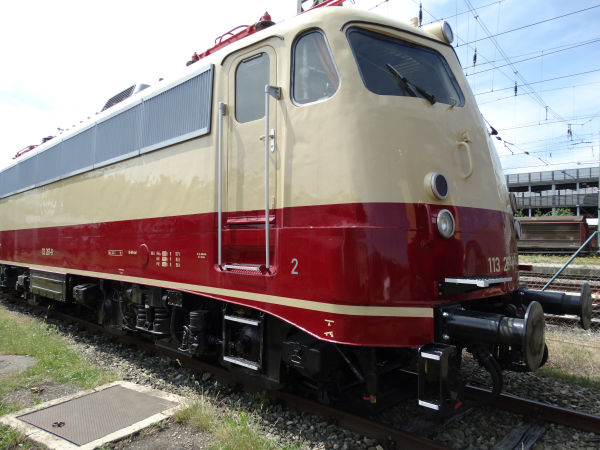
The company Bayernbahn and the Bavarian railway museum are so closely linked together that it's often impossible to distinguish
them from one another. Bayernbahn was originally an operator just for historic trains using old locomotives and coaches, but nowadays
it is also a regional private train operator which runs normal cargo trains, but often with historic locomotives. In this archive
we treat the museum, BEM and Bayernbahn, BYB as if they would be one and the same.
The electric locomotive of the type E10, later Br110, became the forefather of a large family of electric locomotives, all called
standard locomotives (Einheitslokomotiven, unity locomotives). It all started in early 1950s with the E10 with a flat face. It had
two-axle bogies and a welded superstructure. After the first E10 engines came the E10.3 / Br110.3, the so called "Bügelfalte", laundry
ironing iron head, which was otherwise the same, but had a little bit more aerodynamically built forefront. Then, from 1962 onwards
some Br110 locomotives were equipped with Henschel-made bogies and transmissions fit for speeds up to 160 km/h and they were called
from then on E10.12 or a bit later class 112. Then, when in 1991 East and West Germany had fused and the numbering schemes of the west
and the east had to be merged together and there was again from the east a new Br112, these old Br112s got the number Br113. This is
one of them. A classical Trans Europ Express coloured locomotive of the 1970s, but now without the Deutsche Bundesbahn logos. But
otherwise refreshed into what it used to look like when it was new as an E10.12 "Bügelfalte" locomotive, that time the fastest and
most respected German express train locomotive - in 1962 at least.
Picture from the Bayerisches Eisenbahnmuseum (Bavarian railway museum) in Nördlingen 3.7.2019 by Ilkka Siissalo.
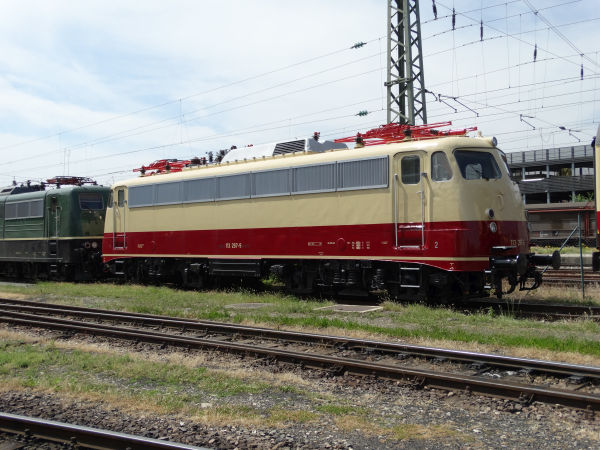
The same old Br 113 (formerly Br 110 variant "Bügelfalte") seen from its side.
Picture from the Bayerisches Eisenbahnmuseum (Bavarian railway museum) in Nördlingen 3.7.2019 by Ilkka Siissalo.
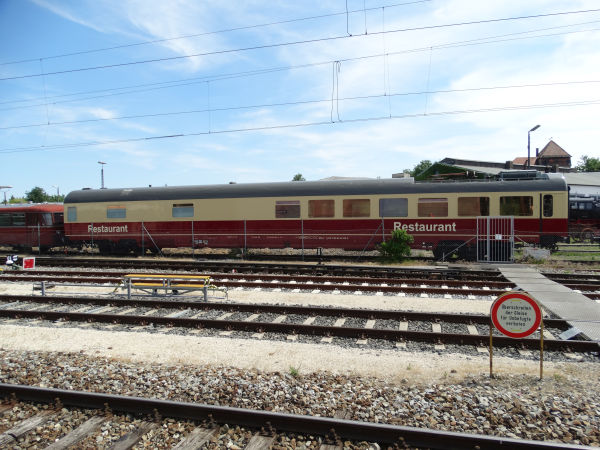
An old restaurant coach of a classical 1960s Trans Europ Express TEE train, in very nice condition, ready for a charter ride.
Picture from the Bayerisches Eisenbahnmuseum (Bavarian railway museum) in Nördlingen 3.7.2019 by Ilkka Siissalo.
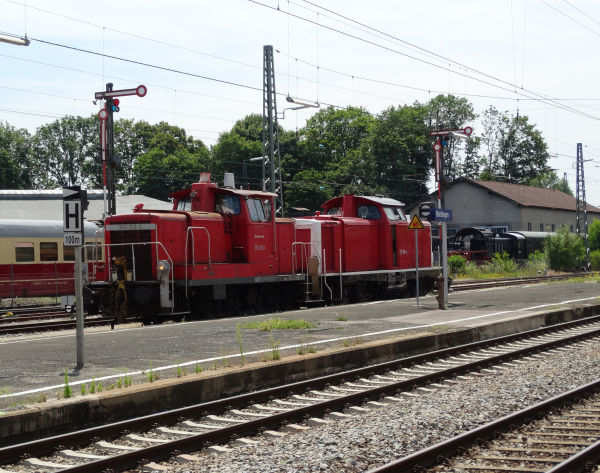
Typical of the Bayernbahn: Oldies in full day to day work. Here a classical DB V60, later class Br363 (on the left) is pulling another classic
locomotive, a former V100, now called Br212 and bringing it to the locomotive sheds.
Picture from the Bayerisches Eisenbahnmuseum (Bavarian railway museum) in Nördlingen 3.7.2019 by Ilkka Siissalo.
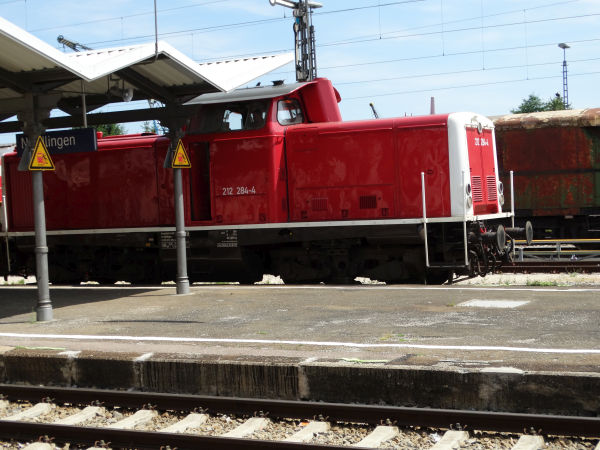
The same former DB V100, now Br 212.
Picture from the Bayerisches Eisenbahnmuseum (Bavarian railway museum) in Nördlingen 3.7.2019 by Ilkka Siissalo.

When the cargo operations of Bayernbahn started to more and more cover the whole of Germany and the cargo trains simultaneously
became more and more heavy, stronger locomotives were needed. Bayernbahn bought first the 151 119-5 in 2015 and later also this
151 016-3. They were thoroughly renovated and painted back in their original chromedioxide green colours to look like they used to
be when they were new. The class Br151 looks much like the other "unity locomotives". The basic design of the locomotives is
already from the 1950s and early sketches existed already during WWII, but these Br151 machines are markedly younger. They were
built 1972-78 to replace fairly similar but older Br 150 machines. It's a fairly modern machine
with a power rating of 6,288 kW and a top speed of 120 km/h.
Picture from the Bayerisches Eisenbahnmuseum (Bavarian railway museum) in Nördlingen 3.7.2019 by Ilkka Siissalo.

Another one of Br 151 locomotives which Bayernbahn has acquired.
Picture from the Bayerisches Eisenbahnmuseum (Bavarian railway museum) in Nördlingen 3.7.2019 by Ilkka Siissalo.

Still another view of a Bayernbahn Br 151.
Picture from the Bayerisches Eisenbahnmuseum (Bavarian railway museum) in Nördlingen 3.7.2019 by Ilkka Siissalo.
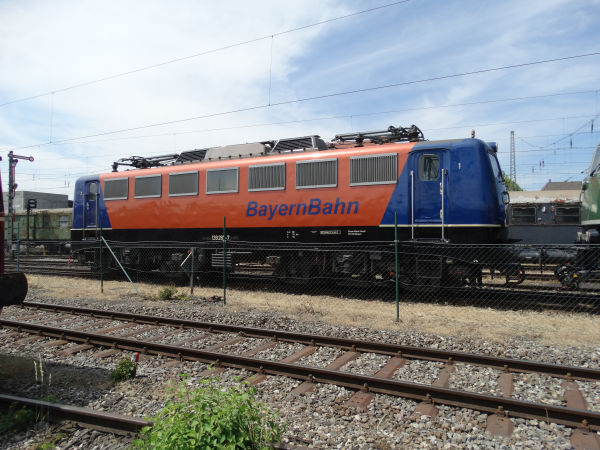
This Bayernbahn machine is today classed as a Br139 machine, but it was built as an express train locomotive of the class Br 110.
In fact this machine was the very last of the so called "Kasten-E10" variant, the version with a flat face. Compare this picture
with the very first locomotive on top of this page - that one is one of the "Bügelfalte"-E10 machines, which were otherwise identical
with this one but for the bit more aerodynamic front face.
Then in 1993-95 DB took bogies from scrapped series Br140 locomotives and put them into 18 locomotives of the class 110, thus making them
class 139 machines. In effect this was modifying an express train locomotive into a cargo machine. This was one of those 18
machines. In 2009 DB Schenker felt it had no use for the machine any more and it was sidetracked. Bayernbahn bought it in 2011
and after a thorough renovation put it in active use again.
Picture from the Bayerisches Eisenbahnmuseum (Bavarian railway museum) in Nördlingen 3.7.2019 by Ilkka Siissalo.

The same Bayernbahn Br 139 machine as above (former DB 110 287). This one was built by Krauss-Maffei and SSW in 1963 as a class 110
express train locomotive. DB sidetracked it in 2009 as they did not see any need for it anymore. Bayernbahn bought it in 2011,
renovated it and put it back to daily use.
Picture from the Bayerisches Eisenbahnmuseum (Bavarian railway museum) in Nördlingen 3.7.2019 by Ilkka Siissalo.

This Bayernbahn Br 212 machine was delivered to DB as V100 no.2100 (later 212 100-2) in 1964. It was built by MaK (Maschinenbau
Aktiengesellschaft Kiel) and it was sent as a one day old locomotive over to Nördlingen for DB to use. In 1980 it was moved over to Augsburg
and then to Mühldorf. In 2006 Bayernbahn had the opportunity to buy it. It has been thoroughly renovated and painted to look
exactly like it did when it was new in 1964.
Picture from the Bayerisches Eisenbahnmuseum (Bavarian railway museum) in Nördlingen 3.7.2019 by Ilkka Siissalo.
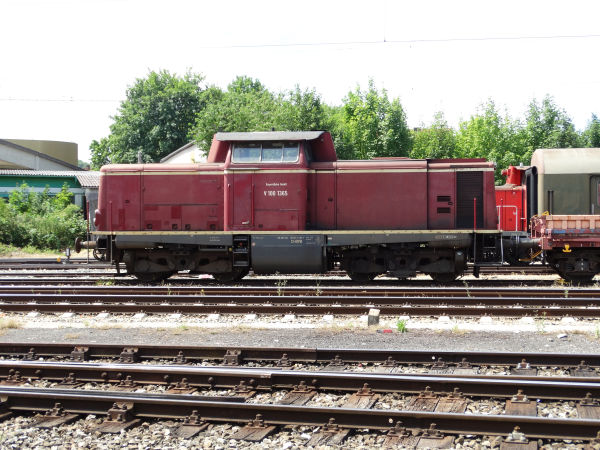
Another one of Bayernbahn's old former DB V100 diesel engines, this V100 no.1365 was built in 1963 by Maschinenfabrik Esslingen. Here we see it
in the same wine red colours that it had when it was new at DB. It is in daily work with real commercial traffic.
Picture from the Bayerisches Eisenbahnmuseum (Bavarian railway museum) in Nördlingen 3.7.2019 by Ilkka Siissalo.
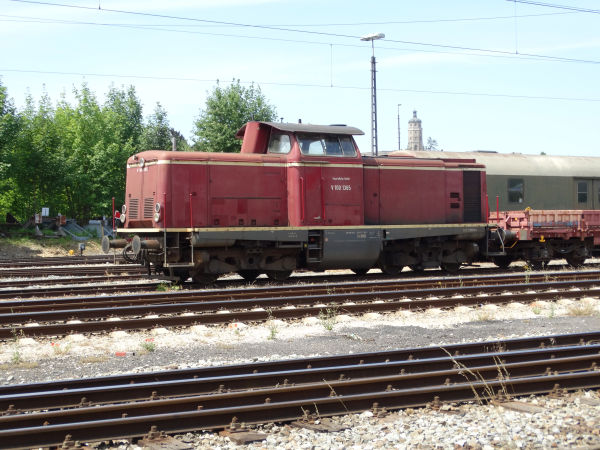
Still another view of the same DB V100 no.1365 as shown above, but seen more from the side of its front no.2.
Picture from the Bayerisches Eisenbahnmuseum (Bavarian railway museum) in Nördlingen 3.7.2019 by Ilkka Siissalo.
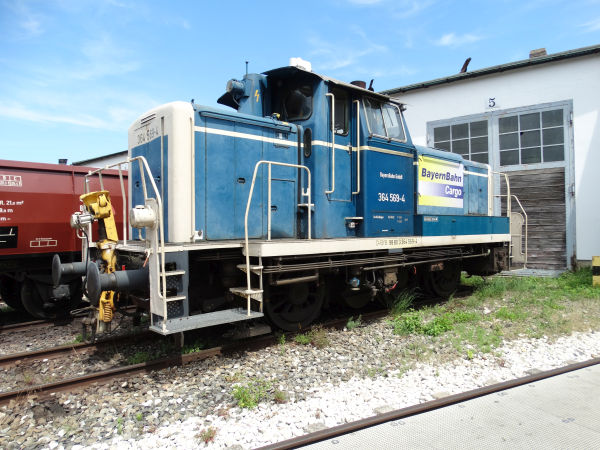
This Bayernbahn Br 364 shunter diesel machine is a former Deutsche Bundesbahn V60 engine and it is seen here in the blue and creme
painting which DB used in the 1980s. Here the machine is in daily use.
Picture from the Bayerisches Eisenbahnmuseum (Bavarian railway museum) in Nördlingen 3.7.2019 by Ilkka Siissalo.
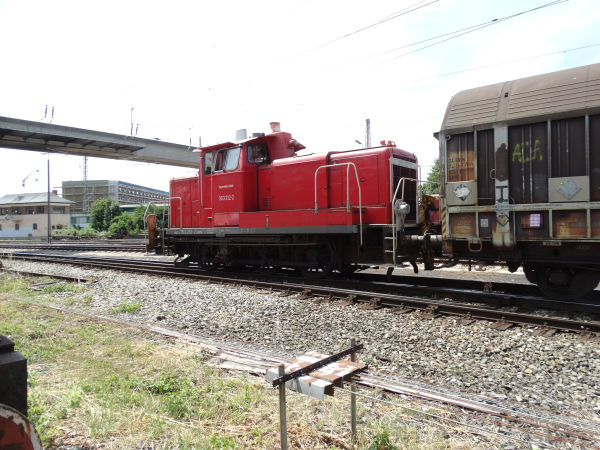
Bayernbahn's Br 363 no.212 is yet another one of the former DB V60 shunter diesel machines, just like the Br 364 shown above,
but this one is a bit heavier variant. It was built by the company Krupp in 1963. Here we see it in DB's so called verkehrsrot (traffic red) painting.
Picture from the Bayerisches Eisenbahnmuseum (Bavarian railway museum) in Nördlingen 3.7.2019 by Ilkka Siissalo.

This Bayernbahn Br 323 small shunter is a type Köf II machine (for more details, see below), but this one is not from the WWII times.
The initial variants of the Köf II had no closed cabinets with proper doors. This one was built in 1959 by the company Gmeinder. It served
at DB in München until 1993.
Picture from the Bayerisches Eisenbahnmuseum (Bavarian railway museum) in Nördlingen 3.7.2019 by Ilkka Siissalo.
Bayerisches Eisenbahnmuseum (Bavarian railway museum), BEM
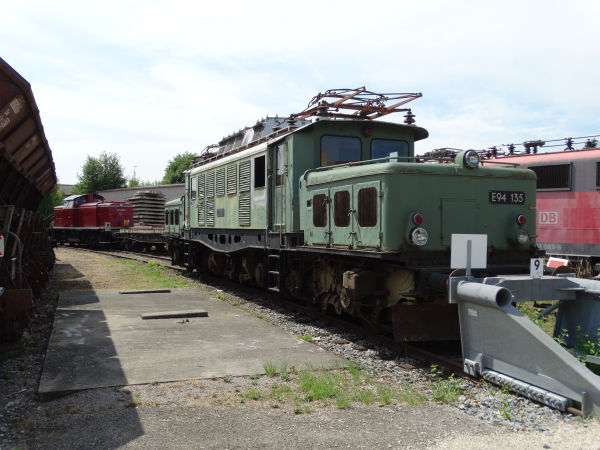
The E94, nicknamed German crocodile was a famous heavy electric locomotive. Built in the 1930s, they were used a long time, well
into the 1980s, and a few are still in active use at private railway companies in 2019. This one has apparently after the second world war
been left in Austria. The Austrians modified these locomotives slightly, for example replaced three small front windscreen windows
with two bigger ones like this one has. In Austria these were called class 1020. This one was built during the war in 1944.
Picture from the Bayerisches Eisenbahnmuseum (Bavarian railway museum) in Nördlingen 3.7.2019 by Ilkka Siissalo.
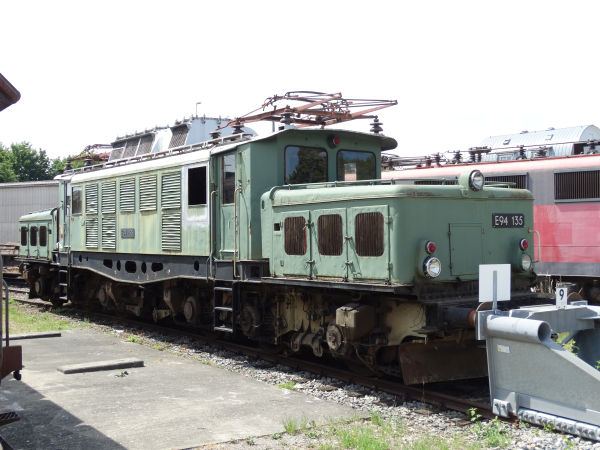
Another view of the same E94 locomotive. The three dark, large ventilation grilles at the lower front sections and the two-part windscreens
tell that this one has once been an Austrian class 1020 machine. Actually this one was delivered as new in 1944 already to Austria.
Picture from the Bayerisches Eisenbahnmuseum (Bavarian railway museum) in Nördlingen 3.7.2019 by Ilkka Siissalo.

For a long time the class 103 (formerly E03) was Germany's fastest, most beautiful and most adored express train locomotive. The very last
ones were still in active use in 2018. This one was built in 1971. It is said to have rolled over 9 million kilometres throughout its
active life. It came to the museum in 2002.
Picture from the Bayerisches Eisenbahnmuseum (Bavarian railway museum) in Nördlingen 3.7.2019 by Ilkka Siissalo.
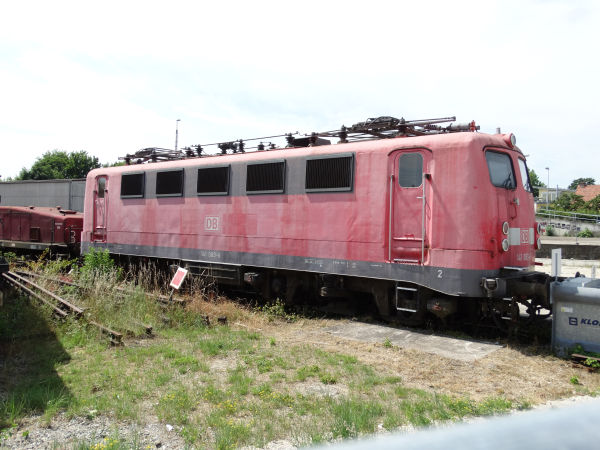
The class 141 was the little bit slower and weaker variant of the so called unity locomotive (Einheitslokomotiven) family. It was intended
for local and regional trains that were stopping frequently, so it did not have to be as fast as the express train variant 110. This one
was built by Henschel in 1959.
Picture from the Bayerisches Eisenbahnmuseum (Bavarian railway museum) in Nördlingen 3.7.2019 by Ilkka Siissalo.

Class V36 was a military locomotive from the 1930s. The reasoning was that it was safer to bring ammunition and other military materials
very close to the front lines with a diesel than with a steam locomotive as the smoke could often reveal the locomotive to enemies.
Quite a large number of these machines were built for the German army and after the war they were used for example in hauling local and
regional passenger trains. Ths one found use in the petroleum tank facility of VTG Tanklager in München-Milbertshofen. Steam locomotives
might spread dangerous sparks in such an area.
Picture from the Bayerisches Eisenbahnmuseum (Bavarian railway museum) in Nördlingen 3.7.2019 by Ilkka Siissalo.
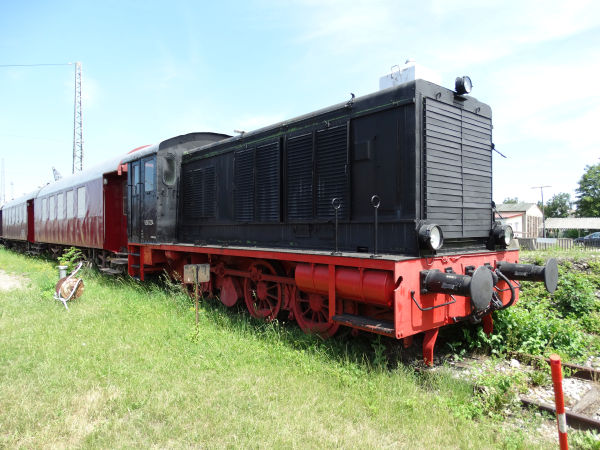
Another view of the same class V36 diesel locomotive as shown above.
Picture from the Bayerisches Eisenbahnmuseum (Bavarian railway museum) in Nördlingen 3.7.2019 by Ilkka Siissalo.
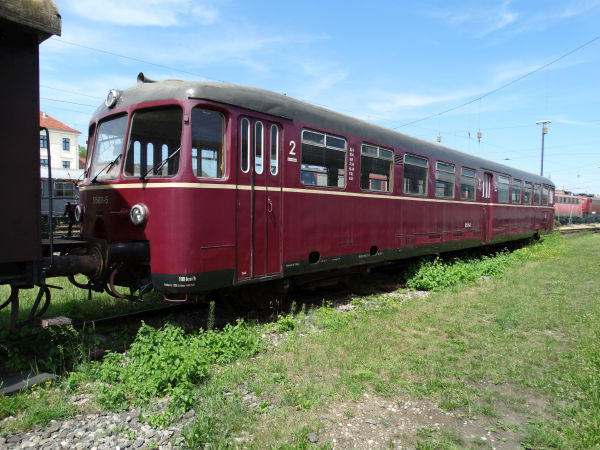
This type ETA 150 (also known as Br 515) was a famous train. They were battery-driven, all electric railbuses intended for short routes where
they could be recharged at the end stations of the route. This one was delivered by Orenstein & Koppel in May 1954 and it was put to service
in Augsburg. The Augsburger ETA 150s came all the way to Nördlingen. This one has now been restored in the colours and equipments that it
used to have in the early 1980s. Traffic with these battery wagons ended in the Augsburg area in 1988.
Picture from the Bayerisches Eisenbahnmuseum (Bavarian railway museum) in Nördlingen 3.7.2019 by Ilkka Siissalo.
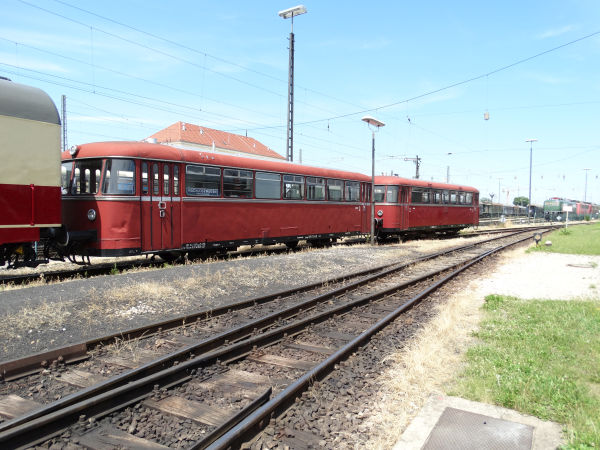
A pair of the very famous VT98 railbuses from the 1950s. Beginning from the mid-1950s these lightweight so called "rattlers" started very quickly
pushing aside ugly and smokey steam engines from side and branch lines. They became so popular that one could speak about a cult train. The coach seen
here on the left is an unmotorised one and the real railbus is the coach further to the right in the picture.
Picture from the Bayerisches Eisenbahnmuseum (Bavarian railway museum) in Nördlingen 3.7.2019 by Ilkka Siissalo.
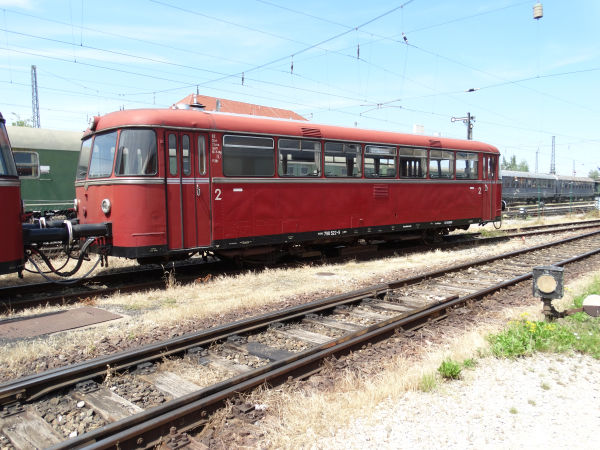
A closer look of the VT 98 - in later notation Br 798 - railbus, the motor wagon. These were also known as Ürdinger railbuses by the factory where they
were built, Waggonfabrik Uerdingen.
Picture from the Bayerisches Eisenbahnmuseum (Bavarian railway museum) in Nördlingen 3.7.2019 by Ilkka Siissalo.
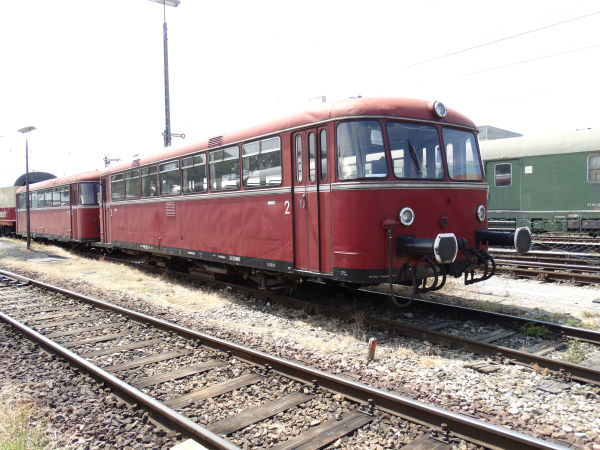
Still the same Ürdinger railbus train as above, but seen from its front.
Picture from the Bayerisches Eisenbahnmuseum (Bavarian railway museum) in Nördlingen 3.7.2019 by Ilkka Siissalo.

This class E63 heavy electric shunter was built by AEG already in 1935, at a time when electric traction was spreading rapidly in southern Germany.
It was used in München, Augsburg and Garmisch-Partenkirchen until 1979 when it was taken out of use as the last one of its class. One private
person saved it from being cut into pieces and the machine was in his private locomotive collection for 28 years. It came to BEM in 2010 and
it has now been put into full working order and painted the way it was when it was new.
Picture from the Bayerisches Eisenbahnmuseum (Bavarian railway museum) in Nördlingen 3.7.2019 by Ilkka Siissalo.
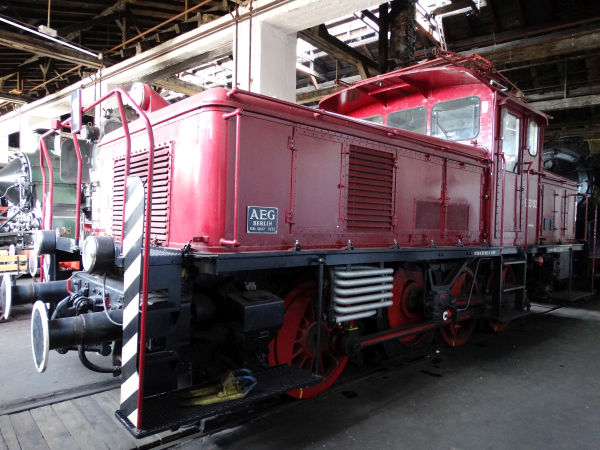
The same E63 shunter as above, but seen more from its side.
Picture from the Bayerisches Eisenbahnmuseum (Bavarian railway museum) in Nördlingen 3.7.2019 by Ilkka Siissalo.
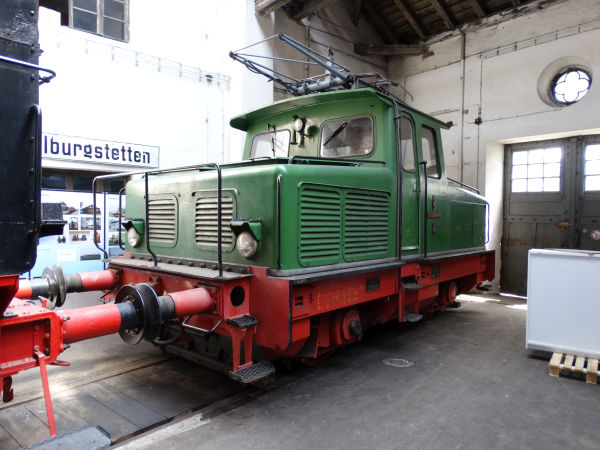
This electric locomotive "Siemensbahn no.4" was built for the company Siemens' own internal factory area network shunting work.
It was built in 1965. It is a 650V DC machine with just a 230 kW power rating but it was anyway already a thyristor technology
locomotive, one of the earliest that existed. In many ways this factory locomotive no.4 was a prototype and trial platform,
which preceded some of the most important advances in electric locomotive development from 1960s to 1980s.
Picture from the Bayerisches Eisenbahnmuseum (Bavarian railway museum) in Nördlingen 3.7.2019 by Ilkka Siissalo.
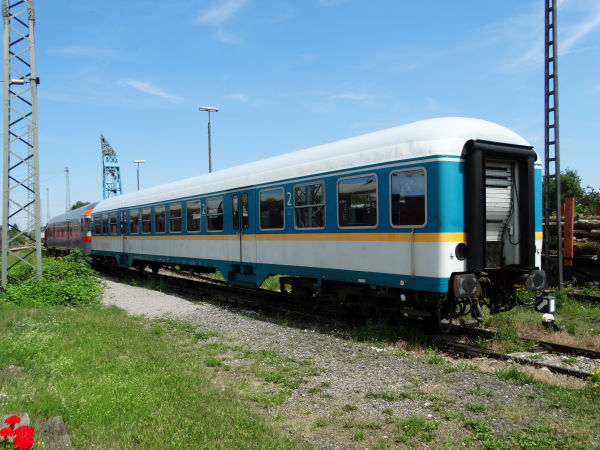
Towards the end of the 1950s it was no longer enough to just refurbish old pre-war coaches. Even the short-haul local routes needed more
modern coaches. The result was a massive programme for new passenger coaches, which later became known as "Silberling" or "n-Wagen"
coaches. They were built by several train making factories but also at the service and repair shops of DB itself. This is one of those
early new standard coaches of the type Bnb 59a. This one was built by DB's own repair shop (Ausbesserungswerk) in Hannover. It was delivered
to service in 1963. It was sold n 2007 to Regentalbahn which used it in its alex trains until 2017. In 2018 it came to the BEM museum.
Picture from the Bayerisches Eisenbahnmuseum (Bavarian railway museum) in Nördlingen 3.7.2019 by Ilkka Siissalo.
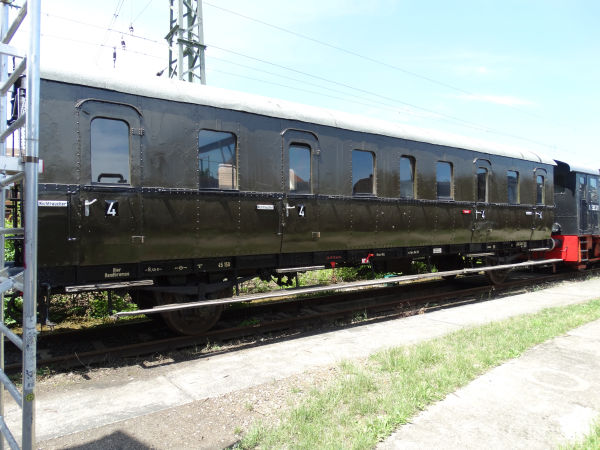
This fourth class coach 45 150 München was built in 1924 by the Waggonfabrik Fuchs in Heidelberg. It served in Frankfurt, Worms, Mainz and
Darmstadt until 1962 after which it served as a temporary home for rail reparation crews. It came to the museum in Nördlingen in 1980.
Picture from the Bayerisches Eisenbahnmuseum (Bavarian railway museum) in Nördlingen 3.7.2019 by Ilkka Siissalo.
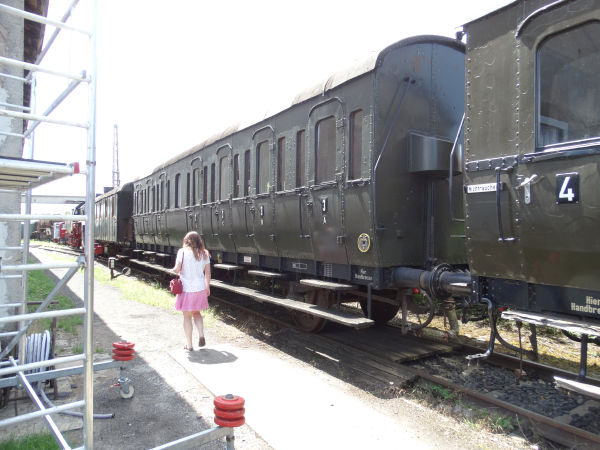
This third class coach 45 410 was built as one of the class C-21 by the company Wumag for the private Lübeck-Büchener Eisenbahn in 1925. After
the LBE became "socialised" and forcefully incorporated into the young German state railways DRG, the coach served in Schwerin. After the chaotic
situation at the end of WW II, the coach remained in Hamburg where it was used until 1962. It came to the museum in 1983 where it was thoroughly
restored to its original condition. It was used in museum trains until 2005.
Picture from the Bayerisches Eisenbahnmuseum (Bavarian railway museum) in Nördlingen 3.7.2019 by Ilkka Siissalo.
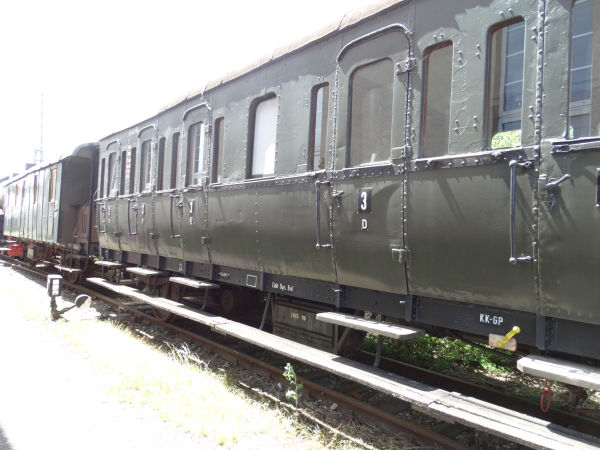
A second view of the same coach 45 410. This was one of the earliest coaches that were allowed to be used in LBE's push-pull trains by a pushing
steam locomotive.
Picture from the Bayerisches Eisenbahnmuseum (Bavarian railway museum) in Nördlingen 3.7.2019 by Ilkka Siissalo.
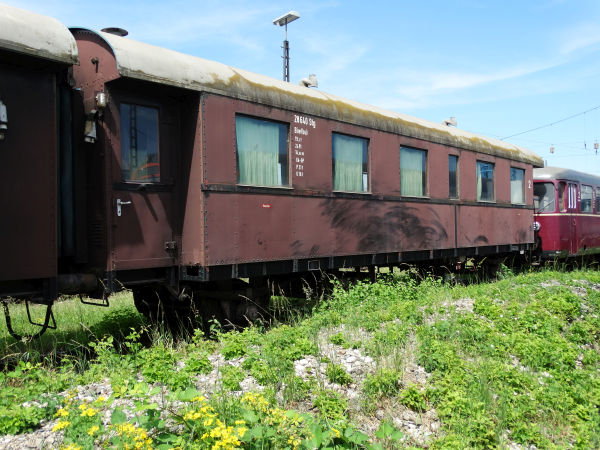
This old coach of the type Bi-29 is either from 1929 or 1930. They were then built by several factories. It has been thoroughly modernised
and renovated in the 1950s and it was after that used on short-haul routes before the new Silberling coaches (see picture above) became
available.
Picture from the Bayerisches Eisenbahnmuseum (Bavarian railway museum) in Nördlingen 3.7.2019 by Ilkka Siissalo.
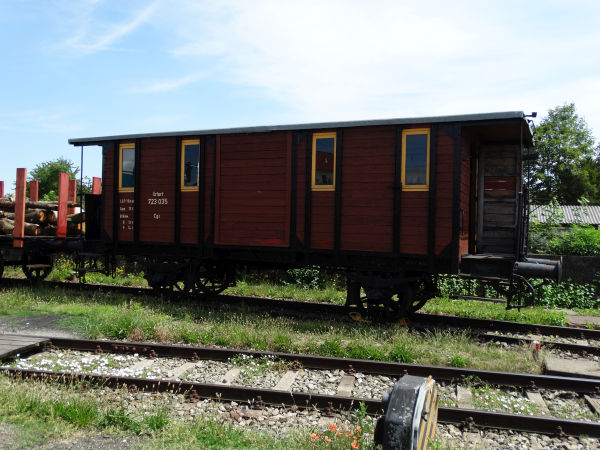
This old Dgi pr-91 wagon, later known as 723 035 Erfurt was from the 1890s. It was a simple, unheated wagon with hard wooden benches.
It could be used as an auxiliary passenger coach during summer time and as a cargo wagon at other times. This one was mainly used
in Meiningen and Oberhof. It was converted in 1930 to a technical supplies wagon for track repair crews and it ended up at the end of
the war in Frankfurt am Main, where it remained as a shed until the 1980s. Now it is rebuilt to almost what it used to look like in the 1890s.
Picture from the Bayerisches Eisenbahnmuseum (Bavarian railway museum) in Nördlingen 3.7.2019 by Ilkka Siissalo.

This is a motor draisine of the type Klv 12. After the second world war, the newly established Deutsche Bundesbahn ordered large numbers
of this kind of small motor draisines for track inspection purposes and also for transporting workers to sites that needed reparation.
Four companies built these draisines: Alpers, Schmitt, Beilhack and Solinger-Hütte. They had a 1200 cm3 Volkswagen engine. The draisine
weighs about 2,2 tonnes and has a top speed rating of 70 km/h. The draisine has under it a hydraulic jack system that enables the crew to lift
the draisine from the rails, turn it 180 degrees around and lower it back onto the tracks.
Picture from the Bayerisches Eisenbahnmuseum (Bavarian railway museum) in Nördlingen 3.7.2019 by Ilkka Siissalo.
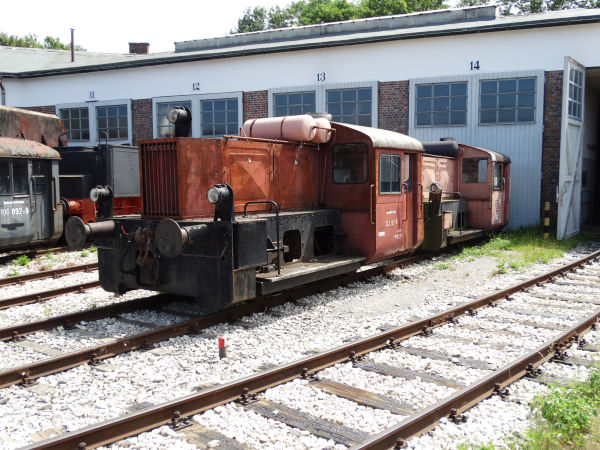
The small locomotive Köf II (later Br 322, in East Germany Br 100) was originally a military locomotive of the Nazi German Wehrmacht. The reasoning
was that in war it was safer to bring ammunition and food for the soldiers very near the front with these small diesel machines rather than steam
locomotives, because the steam clouds would reveal the position of the train to the enemies. Nazi Germany forced also other occupied countries, for
example Denmark to produce these. It became such a popular and handy construction that actually some of these machines were built more than 20 years
after the war and for example in Denmark some of them are still in daily use in 2019.
Picture from the Bayerisches Eisenbahnmuseum (Bavarian railway museum) in Nördlingen 3.7.2019 by Ilkka Siissalo.
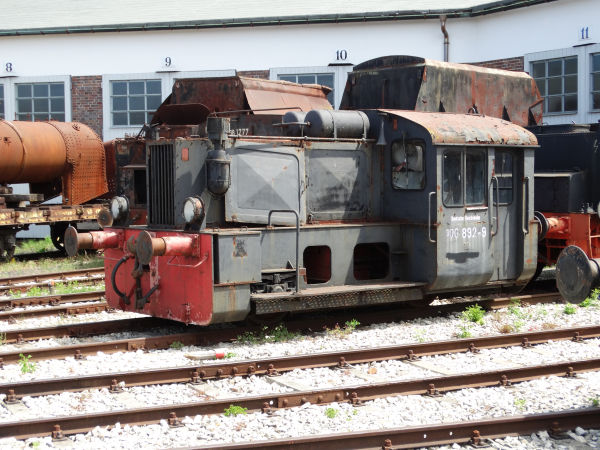
Another Köf II but this one is painted black and marked as Br 100 of the Deutsche Reichsbahn of former communist East Germany.
Picture from the Bayerisches Eisenbahnmuseum (Bavarian railway museum) in Nördlingen 3.7.2019 by Ilkka Siissalo.

The Köf II locomotives shown above (Kleinlokomotive, ölgefeuert, II Generation = small locomotive, fuel [diesel] oil, II gen.) were, as
the name says, of the second generation. This is the first generation (although still older examples exist). This machine Kö 0116 was built in
1934 at Windhoff AG in Rheine. It was used as a small shunter at the station of Mönchehof. After the war it worked in Nürnberg and Friedrichshafen
until 1961 when DB stopped using it and sidetracked it. It was sold to the company Casseler Basalt, which used it at their stone quarries until 1985.
In 1985 the small machine came to the BEM museum.
Picture from the Bayerisches Eisenbahnmuseum (Bavarian railway museum) in Nördlingen 3.7.2019 by Ilkka Siissalo.
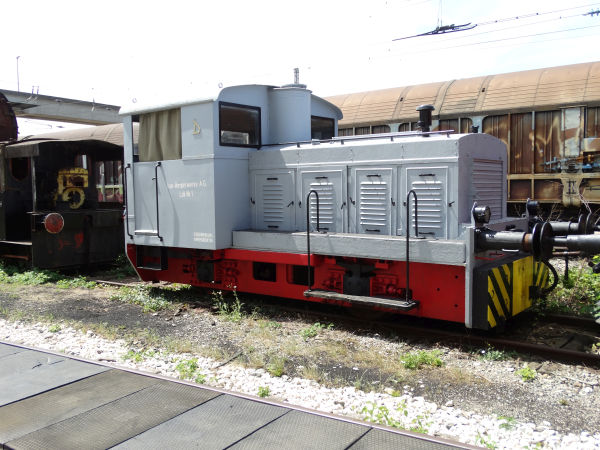
This locomotive no.102 was built during the war in 1939 as a military piece of equipment, made by Die Deutschen Werke AG Kiel. It was delivered to
the explosives factory of Dynamit Nobel AG in Geretsried, which produced ammunition for the Nazi military. After the war much of German military
possessions came under the control of the company Industrie-Verwaltungs-Gesellschaft IVG, the main task of which was to oversee that the machines
and materials were no longer used for military purposes. IVG also sold former military equipment for peaceful use. IVG sold this locomotive in
1957 to the Isar-Amper-Werke which used it for handling of coal trains at the coal power plant of Anglberg. But soon it became too small and too
weak for the growing train loads. In 1986 it was given for a symbolic sum of money to the museum BEM.
Picture from the Bayerisches Eisenbahnmuseum (Bavarian railway museum) in Nördlingen 3.7.2019 by Ilkka Siissalo.
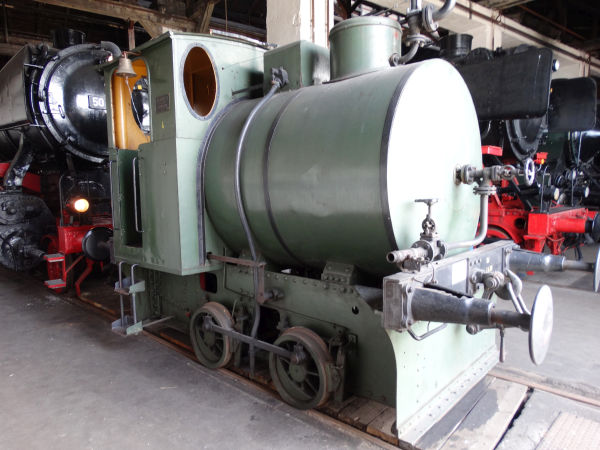
This locomotive no.4 is a "steam bottle" machine which had no fire. It could only operate near a factory where it would tank hot steam from
the factory's equipments. This type of industrial locomotives were popular because they were safe, they did not spread dangerous sparks
in areas where flammable materials were being moved. This one was built by the locomotive factory J.A. Maffei in 1913. It worked 1942 to 1971
at the factory Süd-Chemie in Heufeld.
Picture from the Bayerisches Eisenbahnmuseum (Bavarian railway museum) in Nördlingen 3.7.2019 by Ilkka Siissalo.
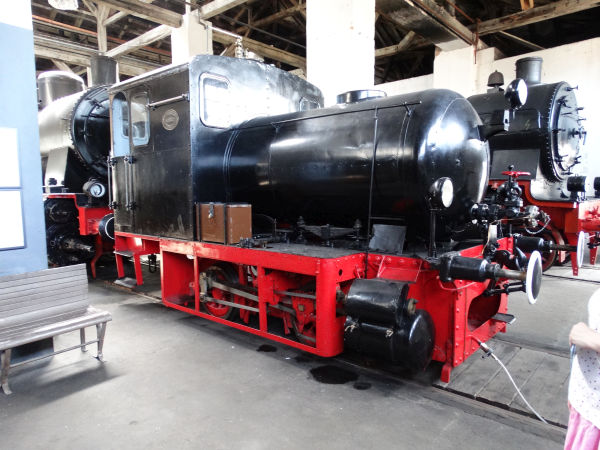
Another "steam bottle", also this machine could only tank superheated steam from a factory and use it for a while until steam ran out,
so it could never go far from its factory. This one was built in 1912 by Krauss & Cie and it had a maximum speed of only 10 km/h. It
was delivered to the city of München and its original task was to fetch wagons loaded with coal from the cargo station of München-Schwabing
and bring the coal to the hospital of Schwabinger Krankenhaus. It did this work for 60 years until it was put aside in 1972. Later it
was used as a teaching object for young people learning the principles of how a steam locomotive works. During that time it moved sometimes
with pressurised air. It was called Dampfspeicherlokomotive 6601, steam conservation locomotive 6601.
Picture from the Bayerisches Eisenbahnmuseum (Bavarian railway museum) in Nördlingen 3.7.2019 by Ilkka Siissalo.

This "steam bottle" fireless locomotive BASF no.5 was built by Hohenzollern AG in 1918 and used by the Badische Anillin- und Sodafabrik BASF
in Ludwigshafen until 1957 and then just stored until 1975. In the 1950s and 1960s BASF was worldwide well known for example as a producer of magnetic tapes.
Picture from the Bayerisches Eisenbahnmuseum (Bavarian railway museum) in Nördlingen 3.7.2019 by Ilkka Siissalo.
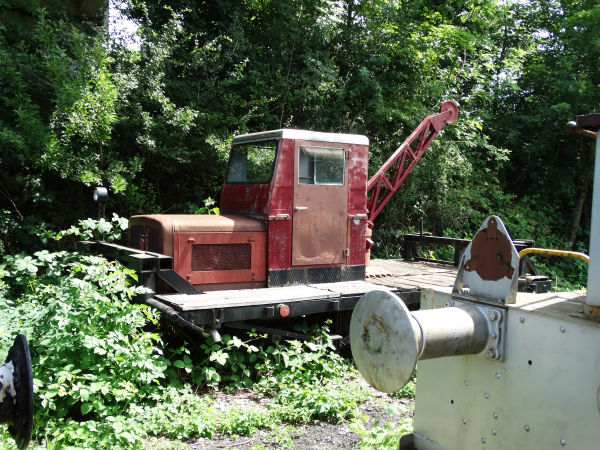
After the war West Germany's DB started quickly acquiring machine power instead of human power for reparations. For example the company Robel
delivered large numbers of small rail trucks such as this one. These Robel's machines were classed as Klv 50 and 51. This one is the Klv 51 no.
8712 built in 1955. It was originally used for fixing damaged track infrastructures, but later in the 1970s modified for work at Bw Lindau,
where they used it for moving and lifting of damaged coaches or coach parts. That's where it got its broad platform-like structures at its sides.
Picture from the Bayerisches Eisenbahnmuseum (Bavarian railway museum) in Nördlingen 3.7.2019 by Ilkka Siissalo.
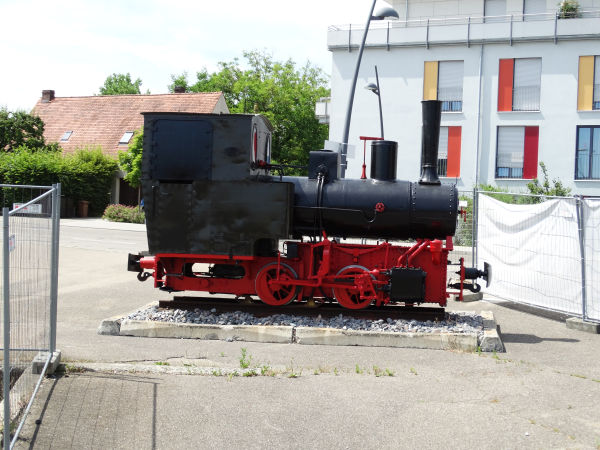
This steam locomotive no.3 named "Luci" was originally ordered by the factory Ishora near St. Petersburg from Orenstein & Koppel in 1914.
It was a 1524 mm gauge machine. But war broke out and it could not be delivered to Russia. In 1916 it was regauged to 1435 mm and delivered
to the Hoechst paint factories where it worked until 1931 and was then transferred to Augsburg. The Hoechst paint factories, Farbwerke Hoechst AG,
was previously known as the company Meister, Lucius & Brüning. From that old name the locomotive got its nickname Luci.
Picture from the Bayerisches Eisenbahnmuseum (Bavarian railway museum) in Nördlingen 3.7.2019 by Ilkka Siissalo.

This class 89 machine no.837 was built by the locomotive factory Krauss in 1921. It was delivered to the newly established German state railways
DRG. But it was not of any new type, but a further order of an older type. The type was a shunter which could run 45 km/h in both directions.
It worked in Bavaria, but in the chaotic situation at the end of the war it was damaged in Austria and thus remained there at BBÖ, later ÖBB. ÖBB took
it out of use in 1956. It was bought by a private company Grazer Schleppbahn-Gesellschaft, which used it until 1972. After standing for ten years outside
it could still be rescued and returned to working order. It came to the museum in Nördlingen in 1984.
Picture from the Bayerisches Eisenbahnmuseum (Bavarian railway museum) in Nördlingen 3.7.2019 by Ilkka Siissalo.
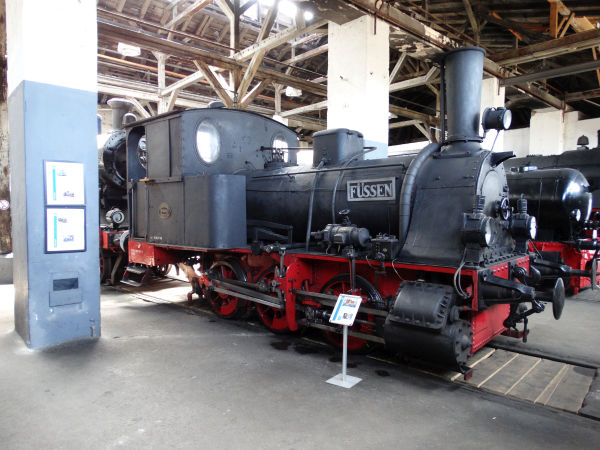
The steam locomotive no.7 "Füssen" was built already in 1889 by the company Locomotivfabrik Krauss & Cie for the Lokalbahn AG LAG which operated private
passenger and goods traffic from München up the hills south to Bichl and Murnau. It was used by LAG until 1928 when it was sold to a paper factory in
Baienfurt. At that time most of LAG's main routes were already electrified and electric locomotives took over. For most of its time in Baienfurt it just
stood as a reserve in case the usual locomotive would stop working, so it remained in fairly good shape. This machine is now the oldest normal gauge
locomotive in operative order in Germany. Since 1889 it has never been officially taken out of use.
Picture from the Bayerisches Eisenbahnmuseum (Bavarian railway museum) in Nördlingen 3.7.2019 by Ilkka Siissalo.
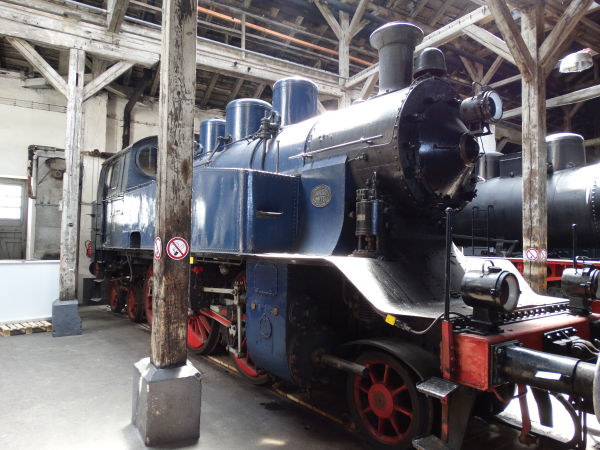
Tegernseebahn TAG no.8 was built by Krauss-Maffei during the war in 1943. Hitler had forbidden to produce anything but "important for the war" locomotives,
so the factory took one wheel truck of an old electric locomotive and integrated that into a completely new locomotive calling it as a "rehaul" of that
old electric machine. The end result was a new locomotive, but one, which was the last one built according to the old Bavarian norms. But the machine was
not used for a long time. In 1959 already it was pushed aside. In 1970 it came to a scrap metal merchant in München who saved it. BEM was able to buy it in 1986.
Picture from the Bayerisches Eisenbahnmuseum (Bavarian railway museum) in Nördlingen 3.7.2019 by Ilkka Siissalo.

The same machine, Tegernseebahn TAG no.8 seen from the other side.
Picture from the Bayerisches Eisenbahnmuseum (Bavarian railway museum) in Nördlingen 3.7.2019 by Ilkka Siissalo.
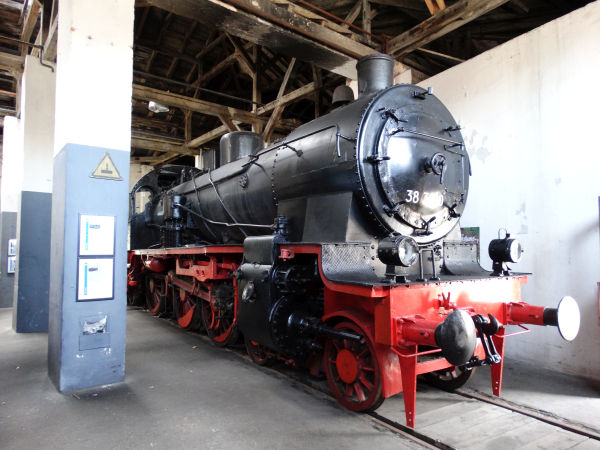
What later became known as the German locomotive class 38, was originally the Prussian class P 8. And at some point of time it seemed that
the whole Europe was full of these Prussian machines. A huge number of P 8 locomotives were built before and during the first world war
and as a result of war damage payments, the Prussians had to give their locomotives to many European nations. These machines were all over the
place. But this famous locomotive type was built also long after the WW I. This individual was built in 1921 by Linke-Hoffman. In 1925 it
got its present day number as 38 3180. The Romanian state railways CFR bought in 1926 around 100 used locomotives from Germany, whose currency
had been hit by the super-inflation and therefore desperately needed foreign currency. Among those roughly 100 locomotives were also 18 machines
of the class P 8 / Br 38 and this was one of them. CFR gave the locomotive the number 230.105 and used it in Timisoara until the 1980s.
Afterwards it was left behind as a badly demolished wreck in Lugoj, Romania. 1998 the museum BEM managed to buy it and restored it. It came to
Nördlingen in 1999.
Picture from the Bayerisches Eisenbahnmuseum (Bavarian railway museum) in Nördlingen 3.7.2019 by Ilkka Siissalo.

This is the last remaining class Br91 steam locomotive. It was built by the factory Schichau-Werke in 1902 and it was known as the locomotive
7235 Magdeburg until the founding of German state railways DRG in 1925. From then on it was known as the 91 406. In 1935 it was sold to the private
Neukölln-Mittenwalder Eisenbahn near Berlin. During 1943 or -44 it suffered there damages from an aerial bombing and was sent to the Tubitze
factories in Belgium for repairs. But the war front moved quicker than the locomotive, and allied forces took over the Tubitze factories before the
machine could be sent back home. The Belgians did not feel they would have a need for this machine, so after the war this one was sold to a paper
factory in Finland together with another similar machine. It worked at the paper factory until 1965 and finally ended up in a railway museum in
Haapamäki, Finland. But as the machine was not of Finnish origin, Finns sold it in 2015 to BEM in Nördlingen. It is still in broad gauge 1524 mm
after the Finns regauged it in 1949.
Picture from the Bayerisches Eisenbahnmuseum (Bavarian railway museum) in Nördlingen 3.7.2019 by Ilkka Siissalo.
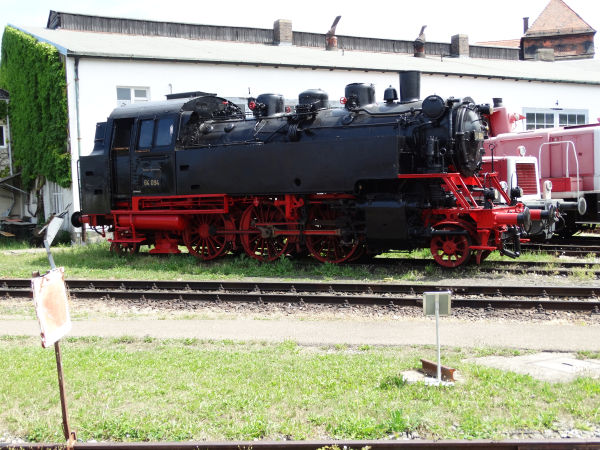
This Br64 locomotive was delivered to DRG in 1928. It was built by the Lokfabrik Maschinenbau-Anstalt Humboldt in Köln. It had a long active life
at various locations until 1973 when it became a memorial at a shopping mall close to Ludwigsburg. Now it is once again restored in working order
as a monument of those times when class Br64 was so important for Nördlingen and its surroundings.
Picture from the Bayerisches Eisenbahnmuseum (Bavarian railway museum) in Nördlingen 3.7.2019 by Ilkka Siissalo.

On the left the same Br 64 steam engine as shown above. In the middle a Br 332 Köf III small diesel shunter locomotive and on the right a class Br 365,
former V60 shunter diesel. Both of the diesel engines are in the 1980s typical painting called "orientrot", oriental red. This picture is actually at
the same time a good demo of why the oriental red painting wasn't used for a long time. It looked good when it was new, but the red colour selected
faded away and turned in bright sunshine in only a couple of years into some kind of a reddish light grey, which really didn't give a good impression to anyone.
Picture from the Bayerisches Eisenbahnmuseum (Bavarian railway museum) in Nördlingen 3.7.2019 by Ilkka Siissalo.
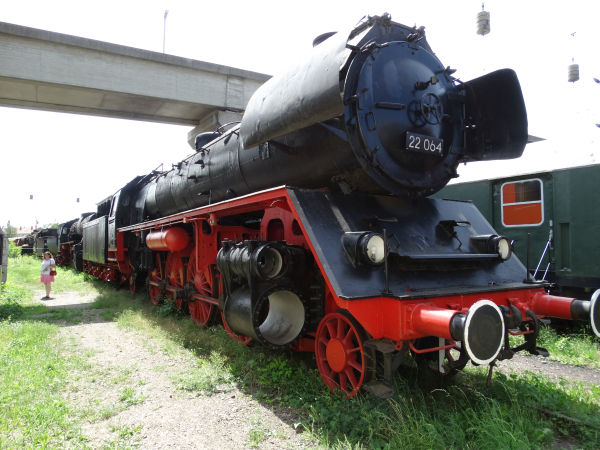
This class 22 no.064 steam engine was delivered as class 39 no.165 from Kassel to the German state railways DRG in 1924. It was totally reconstructed in 1960
after which it got the new classification number of Br 22. It was used in East Germany in the area of Dresden - Reichenbach - Leipzig until so many new electric
locomotives became available that no station wanted it anymore. It was still kept until 1968 as a stationary machine for delivering hot steam to preheat passenger
coaches on cold mornings. It came to the museum of BEM in 1995 after which started the reconstruction work to a fully working machine.
Picture from the Bayerisches Eisenbahnmuseum (Bavarian railway museum) in Nördlingen 3.7.2019 by Ilkka Siissalo.
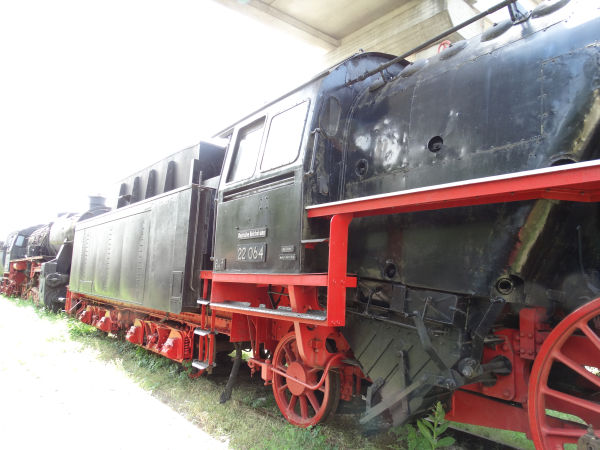
A second view of the same Br 22 machine as shown above.
Picture from the Bayerisches Eisenbahnmuseum (Bavarian railway museum) in Nördlingen 3.7.2019 by Ilkka Siissalo.
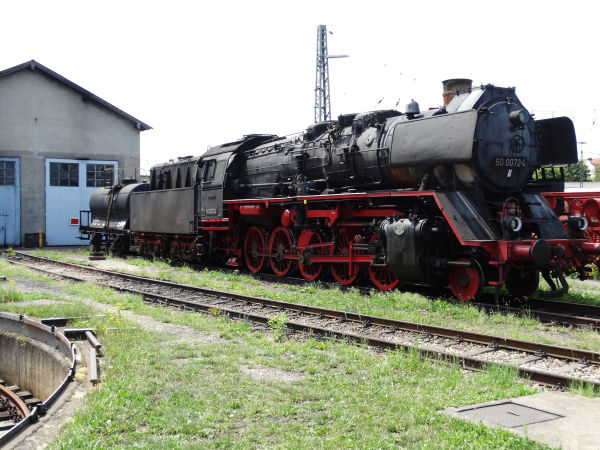
Br 50 was before the war and during the beginning of WWII the most important and most powerful cargo locomotive in Germany. It was also the starting
point of the "simplifying" changes which led to the development of the famous German war locomotive Br 52. This one was built by Krauss-Maffei in 1939
and it remained throughout the war and after it in the east, in what became the DDR. In 1971 it was rebuilt from coal to oil. In 1991 it got a fresh
total renovation and ever since it has been used in museum trains.
Picture from the Bayerisches Eisenbahnmuseum (Bavarian railway museum) in Nördlingen 3.7.2019 by Ilkka Siissalo.
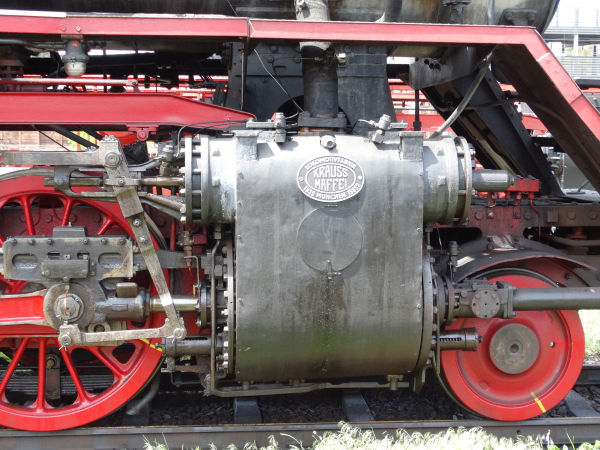
A detail of the same Br 50 machine as above. It has been really beautifully restored and looks like new now.
Picture from the Bayerisches Eisenbahnmuseum (Bavarian railway museum) in Nördlingen 3.7.2019 by Ilkka Siissalo.

A second detail picture of the same machine as above. Note the tender, intended for oil transportation.
Picture from the Bayerisches Eisenbahnmuseum (Bavarian railway museum) in Nördlingen 3.7.2019 by Ilkka Siissalo.
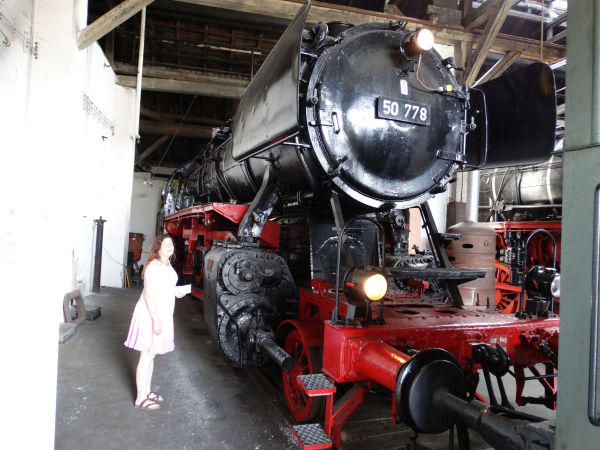
Train photographer Sanna Siissalo standing beside another Br 50 machine. Sanna is 175 cm tall. This shows clearly how huge
these cargo steam engines were. This individual Br 50 was built by Henschel & Sohn in Kassel in 1941.
Picture from the Bayerisches Eisenbahnmuseum (Bavarian railway museum) in Nördlingen 3.7.2019 by Ilkka Siissalo.

Class 52 with its "Wannentender" (bathtub coal tender) was the world famous Hitler's Kriegslokomotive or war locomotive built in so many
copies like no other steam engine ever before or after. It was based on the class Br 50, but as time went by it got more and more simplified.
The idea was that the machines do not have to last for longer than 4-5 years, until Hitler wins his war, but they had to be simple and fast
to build and when one gets damaged, it's just simply pushed aside and another one comes to replace it. Well... It didn't quite work out that way.
For one thing, Adolf Hitler luckily never won his war, but also one could say that the locomotives were still too good. Instead of lasting just
4-5 years, many of them have lasted for well over 50 years and some are actually still operative in 2019. There were a multitude of variants
and actually it's impossible to say where the line between a Br 50 and a Br 52 should be drawn. This machine 52 2195 is more or less the original
Kriegslok. It has not much been modernised or modified like so many hundreds of similar machines in DDR, the Soviet Union, Poland etc. had gone
through. This one was built by Henschel in 1943 and it was sent to RBD Posen in the east. At the end of the war it stood in Dresden. In 1946
it had to be handed over to the Russians as one of the so called Kolonnenloks, long lines of hundreds of locomotives that the Russians forcefully took
as partial war damages repayment as they literally robbed what was to become the state of East Germany. It worked for the red army in
Chemnitz-Hilbersdorf and was then finally returned to East Germany's DR where it
worked until 1991. Today it is outwardly renovated and painted, but not in a shape to move by itself.
Picture from the Bayerisches Eisenbahnmuseum (Bavarian railway museum) in Nördlingen 3.7.2019 by Ilkka Siissalo.
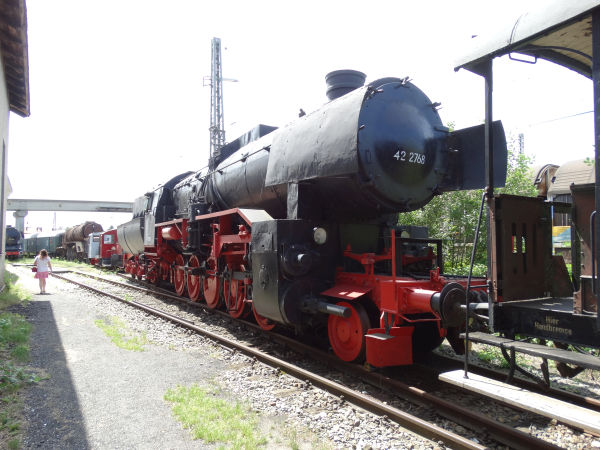
Class 42 of Hitler's Nazi Germany was a kind of a second generation war locomotive after the famous Br52 Kriegslok. The only
individuals that got into use, were delivered right at the end of the war. Nördlingen got one Br 42 locomotive from the very first
production batch. The second batch of these locomotives were intended to be built by the locomotive factory Wiener Lokfabrik Floridsdorf
in Wien, Austria and they were intended for use in Augsburg, but the war front movements were faster. Russians invaded Wien and made
it impossible to either sell these new machines or build more of them. It took until the year 1952 until Austrians could sell this
batch of 30 locomotives. The buyer - dictated by the Russians - was the Bulgarian state railways. This machine was one of them.
The Bulgarians called the machines class 16. In 1994 the museum BEM managed to buy this machine which in Bulgaria was called
16.16. It was restored to the state and to the paintings and markings used by the German DRG towards the end of the war and it
received also the class and number markings originally intended for it, Br 42 no. 2768.
Picture from the Bayerisches Eisenbahnmuseum (Bavarian railway museum) in Nördlingen 3.7.2019 by Ilkka Siissalo.
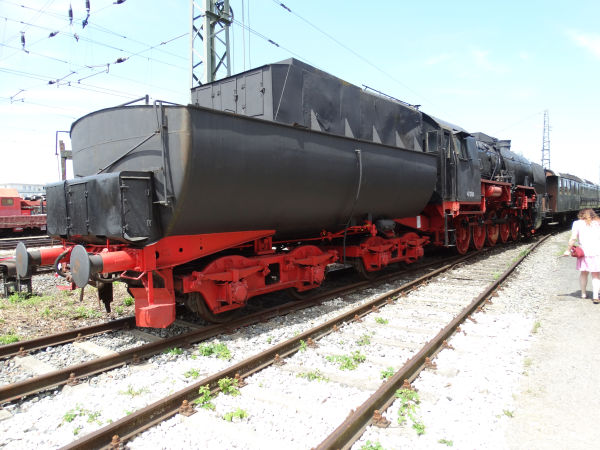
The Wannentender (bathtub coal tender) wagon of the same Br 42 locomotive as above. These Wannentender tender wagons were typical of the
Nazi era Kriegslokomotiv locomotives of the class Br 52.
Picture from the Bayerisches Eisenbahnmuseum (Bavarian railway museum) in Nördlingen 3.7.2019 by Ilkka Siissalo.
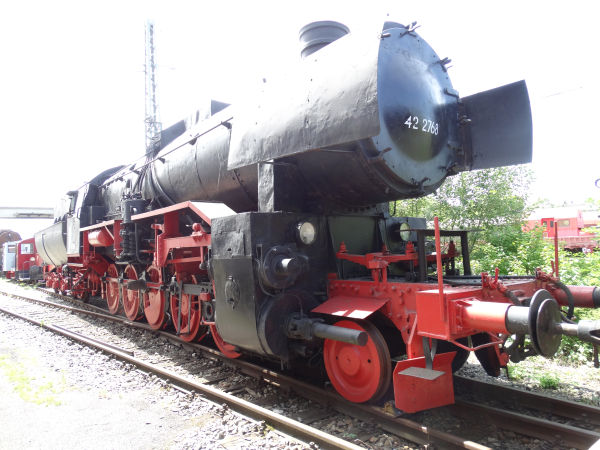
Still a bit closer look at the same Br 42 locomotive as shown above.
Picture from the Bayerisches Eisenbahnmuseum (Bavarian railway museum) in Nördlingen 3.7.2019 by Ilkka Siissalo.
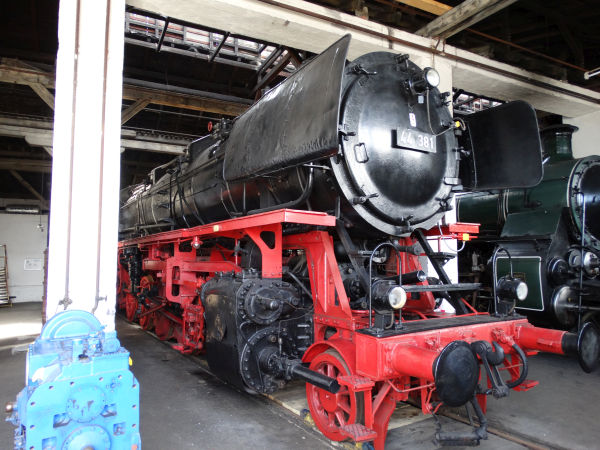
The Br 44 steam locomotives were heavy duty cargo locomotives which were used especially in hauling very heavy iron ore and
coal trains. This one was built by the Maschinenfabrik Esslingen factory in 1941. During the war it served far away in the east,
but was before the end of war returned to what then became West Germany. It was modified from coal to oil heating in 1960. It
was one of the last active steam locomotives of DB and it served until October 1977 in Rheine, pulling iron ore trains.
Picture from the Bayerisches Eisenbahnmuseum (Bavarian railway museum) in Nördlingen 3.7.2019 by Ilkka Siissalo.
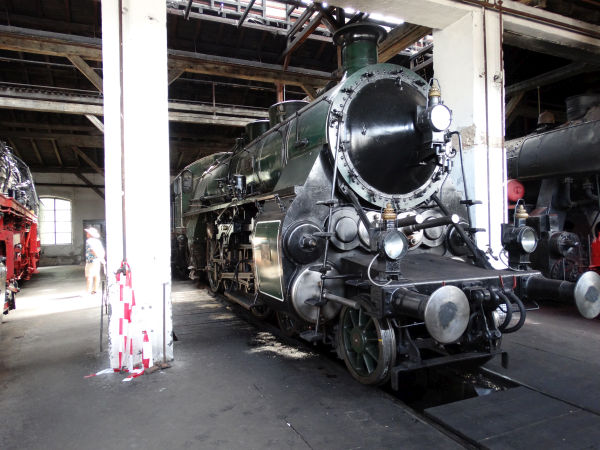
This steam locomotive of the class S 3/6 no.3673 (later Br 18 no.478) was built in 1918 by the company J.A.Maffei for the Köninglich
Bayerischen Staatsbahnen (royal Bavarian state railways). It was used for 42 years in Bavaria. After it was pushed aside from real use,
a Swiss engineer called Serge Lory bought it and used years and years to restore the machine in its original look and feel. It is now
used for pulling historic special tourist trains.
Picture from the Bayerisches Eisenbahnmuseum (Bavarian railway museum) in Nördlingen 3.7.2019 by Ilkka Siissalo.
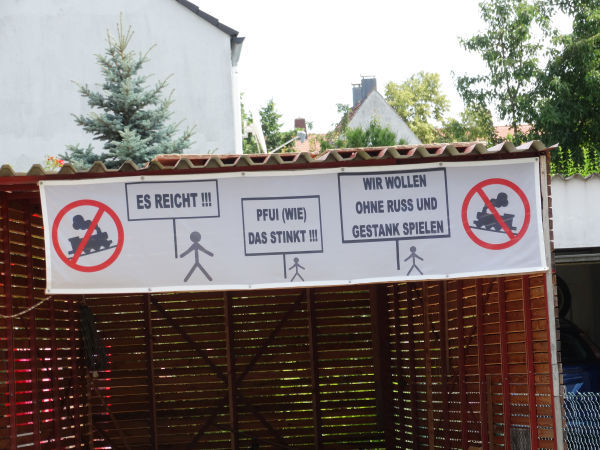
Private home owners seemed to be pretty much pissed off by the BEM museum operating steam locomotives just next to their houses. At least five
private houses had this kind of banners. The texts say "It's enough!!", "Phew how it stinks!!!" and "We want to play without soot flakes and stink".
Picture from near the Bayerisches Eisenbahnmuseum (Bavarian railway museum) in Nördlingen 3.7.2019 by Ilkka Siissalo.
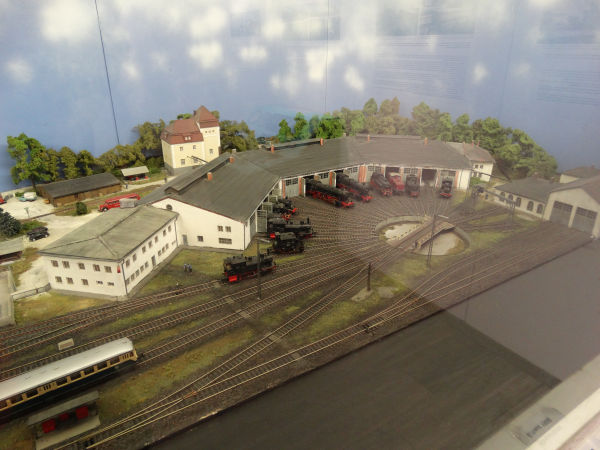
H0 scale (1:87) model of the roundhouse sheds of the museum in Nördlingen.
Picture from the Bayerisches Eisenbahnmuseum (Bavarian railway museum) in Nördlingen 3.7.2019 by Ilkka Siissalo.
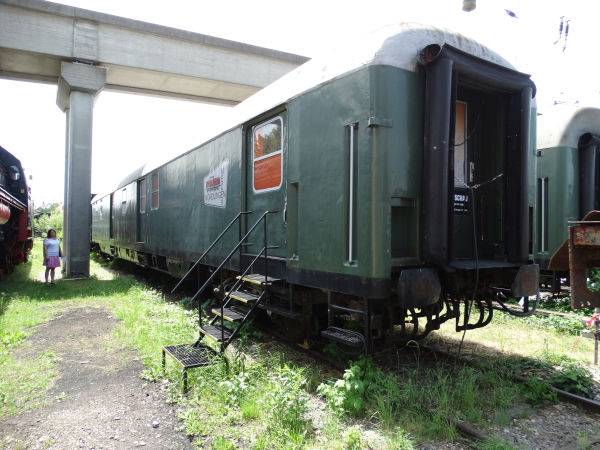
The model railroad club Modelleisenbahnclub Nördlingen (MECEV Nördlingen) has an old express train cargo and post wagon as its clubhouse, parked at a side
track by the BEM museum.
Picture from the Bayerisches Eisenbahnmuseum (Bavarian railway museum) in Nördlingen 3.7.2019 by Ilkka Siissalo.

